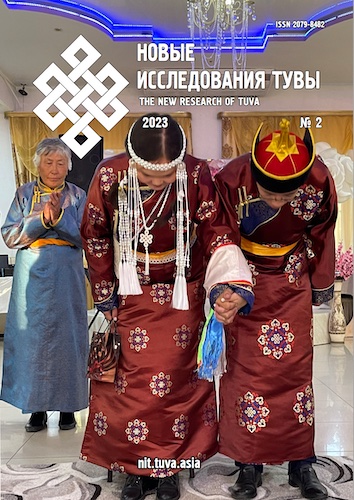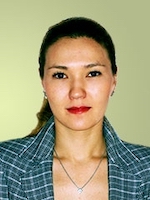Migration of the population in Tuva according to the All-Russian Census of 2020
DOI:
https://doi.org/10.25178/nit.2023.2.1Keywords:
migration; lifetime migration; duration of residence; local natives; all-Russian population census; TuvaAbstract
The article analyzes migration processes in the Republic of Tuva using the data of the All-Russian Population Census of 2020 (the Russian Census of 2020) that was conducted in the fall of 2021. The authors consider the main characteristics of migration cohorts, such as place of birth and features of lifelong migration of the population, duration of residence and acclimation of people to places they move in, issues of registration in places of residence and stay, characteristics of persons temporarily staying in the country, as well as problems of the quality of statistics related to the Russian Census of 2020 at the regional level.
The results of the study have shown that in the inter-census period the number of natives of other regions of Russia decreased in the Republic of Tuva, and the number of visitors from other countries, including Kyrgyzstan, Kazakhstan and China, increased. The majority of the population have permanent registration at their place of residence, but the proportion of people without permanent registration is significantly higher in Tuvan towns than in rural areas, especially among young people. More than half of the residents of Tuva who indicated the duration of their residence had no experience of long-term migration, especially among rural population. The proportion of new settlers in urban areas is higher than in rural territories. This is a consequence of the ongoing urbanization of the region.
The study has revealed that despite the shortcomings, the 2020 population census has allowed to obtain information about migration from a different angle, rather than the traditionally used data from the continuous survey, and to collect unique data on small population groups, including those with migration experience.
References
Abylkalikov, S. I. and Baimurzina, G. R. (2022) Osobennosti demograficheskikh protsessov v gorodakh Kyzyl i Elista v 2011–2020 gody: sravnitel’nyi analiz [Demographic processes in the towns of Kyzyl and Elista in 2011–2020: A comparative study]. New Research of Tuva, no. 2, pp. 34–52. (In Russ.). DOI: https://doi.org/10.25178/nit.2022.2.3
Abylkalikov, S. I. (2016) Urozhentsy stran byvshego SSSR v strukture naseleniia sovremennoi Rossii [Natives of the former Soviet Union countries in contemporary Russia]. Sotsiologicheskie issledovaniia, no. 4, pp. 42–49. (In Russ.).
Abylkalikov, S. I. (2021) Osobennosti demograficheskogo razvitiia Tuvy: vklad migratsii v demograficheskii balans [Features of demographic development of Tuva: Contribution of migration to the demographic balance]. New Research of Tuva, no. 4, pp. 131–142. (In Russ.). DOI: https://doi.org/10.25178/nit.2021.4.10
Anaiban, Z. V. (2020) Sovremennaia migratsionnaia situatsiia v Respublike Tyva [Contemporary migration situation in the Republic of Tuva]. Sciences of Europe, no. 49–4 (49), pp. 62–66. (In Russ.).
Andreev, E. M. (2012) O tochnosti rezul'tatov rossiiskikh perepisei naseleniia i stepeni doveriia k raznym istochnikam informatsii [On the accuracy of the results of the Russian population censuses and the degree of trust in various sources of information]. Voprosy statistiki, no. 11, pp. 21–35. (In Russ.).
Valiakhmetov, R. M., Baimurzina, G. R., Turakayev, M. S. and Samba, A. D.-B. (2021) Etnosotsialnye osobennosti zaniatosti naseleniia v respublikakh Tuva i Bashkortostan [Ethnic and social features of employment in the Republics of Tuva and Bashkortostan]. New Research of Tuva, no. 4, pp. 206–222. (In Russ.). DOI: https://doi.org/10.25178/nit.2021.4.15
Vishnevskii, A. G. (2014) Demograficheskaia revoliutsiia meniaet reproduktivnuiu strategiiu vida Homo sapiens [The demographic revolution is changing the reproductive strategy of Homo sapiens]. Demographic Review, vol. 1, no. 1, pp. 6–33. (In Russ.). DOI: https://doi.org/10.17323/demreview.v1i1.1825
Gaifullin, A. Yu. (2022) Etnodemograficheskie kharakteristiki molodezhi v respublikakh Tyva i Bashkortostan [Ethnodemographics of youth in the republics of Tuva and Bashkortostan]. New Research of Tuva, no. 2, pp. 128–142. (In Russ.). DOI: https://doi.org/10.25178/nit.2022.2.9
Gonchikov, Ts. D., Mandyt, M. K., Gomboev, B. O., Urbanova, Ch. B. and Khal’baeva, S. R. (2019) Migratsiia naseleniia kak faktor formirovaniia i razmeshcheniia naseleniia regiona (na primere Respubliki Tyva) [Human migration as a formation factor and location of the population in the region (on the basis of the Republic of Tuva)]. Izvestiia Dagestanskogo gosudarstvennogo pedagogicheskogo universiteta. Estestvennye i tochnye nauki, vol. 13, no. 1, pp. 56–65. (In Russ.).
Zayonchkovskaya, Zh. A. (1972) Novosely v gorodakh (metody izucheniia prizhivaemosti) [Newly arrived city dwellers (Methods of studying acclimation)]. Moscow, Statistika. 164 p. (In Russ.).
Lamazhaa, Ch. K. (2014) Zasaianskie tuvintsy: obraz zhizni, tsennosti, idealy [Tuvans beyond the Sayan Mountains: Way of living, values and ideals]. New Research of Tuva, no. 3, pp. 152–165. (In Russ.).
Mkrtchyan, N. V. (2011) Dinamika naseleniia regionov Rossii i rol’ migratsii: kriticheskaia otsenka na osnove perepisei 2002 i 2010 gg. [Population dynamics of Russia’s regions and the role of migration: Critical assessment based on the 2002 and 2010 censuses]. Izvestiia Rossiiskoi akademii nauk. Seriia geograficheskaia, no. 5, pp. 28–41. (In Russ.).
Perevedentsev, V. I. (1975) Metody izucheniia migratsii naseleniia [Methods of research into population migration]. Moscow, Nauka. 231 p. (In Russ.).
Pyankova, A. I. (2014) Metodicheskie problemy sopostavimosti dannykh perepisei naseleniia 2002 i 2010 godov (na primere Moskovskoi oblasti) [Methodological problems of comparability of census data for 2002 and 2010 (the case of Moscow region)]. Regional’nye issledovaniia, no. 1 (43), pp. 109–121. (In Russ.).
Ryazantsev, S. V., Rostovskaya, T. K. and Davletshina, L. A. (2022) Aktual’nye problemy demografii i podgotovki demografov v Tuve [Current issues of demography and training of demographers in Tuva]. New Research of Tuva, no. 4, pp. 146–168. (In Russ.). DOI: https://doi.org/10.25178/nit.2022.4.12
Samba, A. D. (2020) Osnovnye izmeneniia v sotsial’no-trudovom prostranstve Respubliki Tyva [Major changes in the socio-labor space of the Republic of Tyva]. Ekonomika i upravlenie: nauchno-prakticheskii zhurnal, no. 1 (151), pp. 47–50. (In Russ.). DOI: https://doi.org/10.34773/EU.2020.1.12
Kharunova, M. M.-B. and Kharunov, R. Sh. (2021) Osobennosti formirovaniia gorodskogo rasseleniia v Tuve v sovetskii period [Features of urban settlement in Tuva in the Soviet period]. New Research of Tuva, no. 3, pp. 137–147. (In Russ.). DOI: https://doi.org/10.25178/nit.2021.3.11
Abylkalikov, S. I. (2016) Migration activity and adaptation of Russian regional populations. Regional Research of Russia, vol. 6, no. 4, pp. 357–365. DOI: http://doi.org/10.1134/S207997051604002X
Abylkalikov, S. I. and Sazin, V. S. (2019) Migration in the Kaliningrad region reflected in the 1989–2015 censuses and microcensuses. Baltic Region, vol. 11, no. 2, pp. 32–50. DOI: https://doi.org/10.5922/2079-8555-2019-2-3
Dustmann, C. and Weiss, Y. (2007) Return migration: Theory and empirical evidence from the UK. British Journal of Industrial Relations, vol. 45, no. 2, pp. 236–256. DOI: https://doi.org/10.1111/j.1467-8543.2007.00613.x
Dyson, T. (2011) The role of the demographic transition in the process of urbanization. Population and Development Review, vol. 37, no. s1, pp. 34–54. DOI: https://doi.org/10.1111/j.1728-4457.2011.00377.x
Karachurina, L. B. and Mkrtchyan, N. V. (2020) Age-specific migration in regional centres and peripheral areas of Russia. Comparative Population Studies, vol. 44, pp. 413–446. DOI: http://doi.org/10.12765/CPoS-2020-12en
Rogers, A., Watkins, J. F. and Woodward, J. A. (1990) Interregional elderly migration and population redistribution in four industrialized countries: A comparative analysis. Research on Aging, vol. 12, no. 3, pp. 251–293. DOI: https://doi.org/10.1177/0164027590123001
Published
How to Cite
For citation:
Abylkalikov S. I., Baimurzina G. R. and Batalov R. O. Migratsiia naseleniia v Tuve po dannym Vserossiiskoi perepisi naseleniia 2020 goda [Migration of the population in Tuva according to the All-Russian Census of 2020]. New Research of Tuva, 2023, no. 2, pp. 6-16. (In Russ.). DOI: https://doi.org/10.25178/nit.2023.2.1
Issue
Section

This work is licensed under a Creative Commons Attribution-NonCommercial 4.0 International License.

Author(s) license holder(s) grant rights for their work to the journal (grantee of a license) under the simple non-exclusive open license in accordance with Art. 1286.1 «Open license for a research work, work of literature or fine arts», Civil Code of the Russian Federation.
New Research of Tuva publishes articles under the Creative Commons Attribution-NonCommercial license (CC BY-NC).
Since it is an open license, author(s) reserve the right to upload the article to their institutional repository, submit it to another journal (if it allows republications), or republish it on their own website (in full, or in part).
However, several conditions apply here:
a) The republished version must always contain the name(s) and affiliation(s) of the author(s), the original title and the hyperlink to the original version on the New Research of Tuva website;
b) It must be in open access, free of charge, and no category of readers must be in any way whatsoever advantaged over general readership.
c) should the contribution be submitted elsewhere by its author(s) without substantial modification (30% or more of original text unchanged), the body of the article should contain a disclaimer that the original version was published in New Research of Tuva (with a link to the respective page)
The CC-BY-NC is a non-revocable license which applies worldwide and lasts for the duration of the work’s copyright.











